- Clone
- Pin.1 (See other available formats)
- Regulatory Status
- RUO
- Other Names
- MHC Class II associated invariant chain, invariant chain, Ii, MHC class II chaperone, MIF receptor, DHLAG, HLADG
- Isotype
- Mouse IgG1, κ
- Ave. Rating
- Submit a Review
- Product Citations
- publications
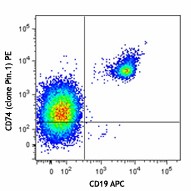
-

Human peripheral blood lymphocytes were surface stained with CD19 APC, fixed and permeabilized, and then stained with CD74 (clone Pin.1) PE (top) or mouse IgG1, κ PE isotype control (bottom). -

| Cat # | Size | Price | Quantity Check Availability | Save | ||
|---|---|---|---|---|---|---|
| 357603 | 25 tests | 117 CHF | ||||
| 357604 | 100 tests | 275 CHF | ||||
CD74 is a type II transmembrane glycoprotein also known as MHC class II associated invariant chain, invariant chain, Ii, MHC class II chaperone, and MIF receptor. CD74 exists in four isoforms with molecular masses of 33, 35, 41, and 43 kD, depending on genetic splicing. CD74 is primarily expressed on antigen presenting cells, including B cells, monocytes/macrophages, dendritic cells, and Langerhans cells. It is also expressed by activated T cells and activated endothelial and epithelial cells as well as carcinomas of lung, renal, gastric and thymic origin. The primary function of CD74 is intracellular sorting of MHC class II molecules and regulation of exogenous peptide loading onto MHC class II. It is also involved in the modulation of B cell differentiation and positive selection of CD4+ T cells. It has been reported that CD74 binds MIF (macrophage migration inhibitory factor) and signals through CD44 to regulate innate and adaptive immunity. It is also reported that H. pylori infection occurs through urease B binding of CD74 on gastric epithelial cells, inducing gastric epithelial cell apoptosis, NF-κB activation, and IL-8 production.
Product DetailsProduct Details
- Verified Reactivity
- Human
- Antibody Type
- Monoclonal
- Host Species
- Mouse
- Immunogen
- Synthetic peptide DQKPVMDDQRDLISNNE, corresponding to amino acids 12-28 of the cytoplasmic tail of human CD74.
- Formulation
- Phosphate-buffered solution, pH 7.2, containing 0.09% sodium azide and BSA (origin USA)
- Preparation
- The antibody was purified by affinity chromatography and conjugated with PE under optimal conditions.
- Concentration
- Lot-specific (to obtain lot-specific concentration and expiration, please enter the lot number in our Certificate of Analysis online tool.)
- Storage & Handling
- The antibody solution should be stored undiluted between 2°C and 8°C, and protected from prolonged exposure to light. Do not freeze.
- Application
-
ICFC - Quality tested
- Recommended Usage
-
Each lot of this antibody is quality control tested by intracellular immunofluorescent staining with flow cytometric analysis. For flow cytometric staining, the suggested use of this reagent is 5 µl per million cells in 100 µl staining volume or 5 µl per 100 µl of whole blood.
- Excitation Laser
-
Blue Laser (488 nm)
Green Laser (532 nm)/Yellow-Green Laser (561 nm)
- Product Citations
-
- RRID
-
AB_2561938 (BioLegend Cat. No. 357603)
AB_2561939 (BioLegend Cat. No. 357604)
Antigen Details
- Structure
- Type II transmembrane glycoprotein, 33, 35, 41, 43 kD
- Distribution
-
B cells and other antigen presenting cells, activated T cells, activated endothelial and epithelial cells, and certain carcinomas
- Function
- Regulate loading of exogenous peptides onto MHC class II and B cell differentiation, involved in positive selection of CD4+ T cells.
- Interaction
- Associates with MHC II
- Ligand/Receptor
- HLA-DR, MIF, H. pylori urease B, associate with CD44
- Cell Type
- B cells, Antigen-presenting cells, T cells, Endothelial cells, Epithelial cells
- Biology Area
- Immunology, Innate Immunity
- Molecular Family
- CD Molecules, MHC Antigens
- Antigen References
-
1. Koch N, et al. 1991. J. Immunol. 147:2643.
2. Wilson KM, et al. 1993. Immunology 79:331.
3. Moldenhauer G, et al. 1999. Immunology 96:473.
4. Shi X, et al. 2006. Immunity 25:595.
5. Beswick EJ, et al. 2006. Infect. Immun. 74:1148.
6. Zola H, et al. 2007. Leukocyte and Stromal Cell Molecules: The CD Markers Wiley-Liss A John Wiley & Sons Inc, Publication. - Gene ID
- 972 View all products for this Gene ID
- UniProt
- View information about CD74 on UniProt.org
Related FAQs
- What type of PE do you use in your conjugates?
- We use R-PE in our conjugates.
Other Formats
View All CD74 Reagents Request Custom Conjugation| Description | Clone | Applications |
|---|---|---|
| PE anti-human CD74 (Cytoplasmic) | Pin.1 | ICFC |
| APC anti-human CD74 (Cytoplasmic) | Pin.1 | ICFC |
| PE/Cyanine7 anti-human CD74 (Cytoplasmic) | Pin.1 | ICFC |
| PerCP/Cyanine5.5 anti-human CD74 (Cytoplasmic) | Pin.1 | ICFC |
Customers Also Purchased
Compare Data Across All Formats
This data display is provided for general comparisons between formats.
Your actual data may vary due to variations in samples, target cells, instruments and their settings, staining conditions, and other factors.
If you need assistance with selecting the best format contact our expert technical support team.
-
PE anti-human CD74 (Cytoplasmic)

Human peripheral blood lymphocytes were surface stained with... 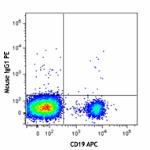
-
APC anti-human CD74 (Cytoplasmic)
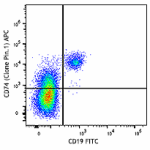
Human peripheral blood lymphocytes were surface stained with... 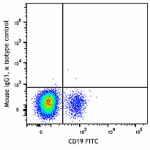
-
PE/Cyanine7 anti-human CD74 (Cytoplasmic)

Human peripheral blood lymphocytes were surface stained with... -
PerCP/Cyanine5.5 anti-human CD74 (Cytoplasmic)

Human peripheral blood lymphocytes were surface stained with...
 Login / Register
Login / Register 










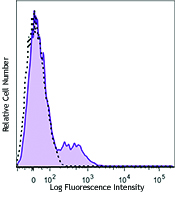


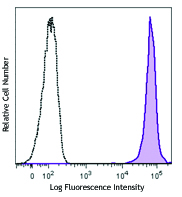



Follow Us